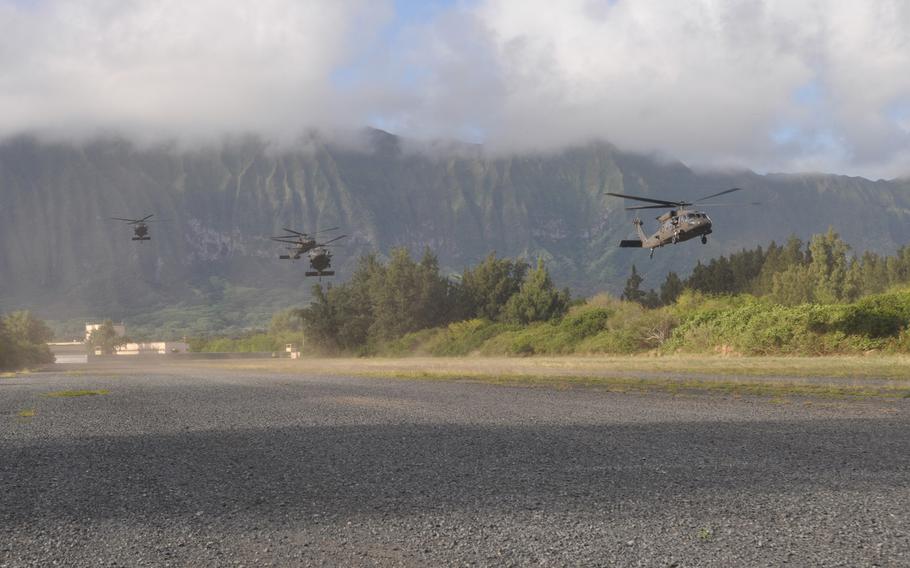
Army Blackhawk helicopters arrive at Marine Corps Training Area Bellows in Hawaii Feb. 5, 2016, during an air assault for Exercise Lightning Forge. Wyatt Olson Stars and Stripes (Wyatt Olson/Stars and Stripes)
MARINE CORPS TRAINING AREA BELLOWS, Hawaii — The Army’s conversion of Hawaii’s Stryker brigade into an infantry team is playing out in earnest with Exercise Lightning Forge, which culminated with an air assault and 100 soldiers raiding a mock terrorist stronghold Friday at this seaside facility.
At the center of the training is the 25th Infantry Division’s 2nd Brigade Combat Team, which is in the midst of trading in its Strykers for infantry gear.
“We’ll come out of this exercise and start immediately doing that organic conversion, as far as moving the Strykers and everything else associated with a combat Stryker brigade,” said T.J. Holland, the brigade’s command sergeant major.
“Then we’ll start bringing in the equipment that’s organic to an infantry combat brigade.”
The Lightning Forge exercise will speed that process.
The Strykers are moving to an armored brigade in Washington state, beginning perhaps as soon as March.
“Army isn’t losing the lethality of a Stryker brigade because they’re moving that to the Western seaboard with a National Guard unit,” Holland said.
“There’s still going to be a Stryker brigade unit that can project power into the Pacific,” he said. “What the Army has gained is another infantry combat brigade out here. We’re building a different type of lethality that’s more fitting in the Pacific [region].”
The transition means eliminating about 1,200 positions, many of which will have been vacated through attrition by the end of the year-long conversion.
Holland described the conversion as “fiscally responsible.”
“It’s expensive to train — as a brigade — with Strykers on this island because we’d have to project that force back to the mainland to do anything,” Holland said. “In the long term we’re saving the Army money, but we’re still maintaining that readiness.”
Lightning Forge uses the Joint Pacific Multinational Readiness Capability system, which is an integrated system of deployable shelters, software and hardware that links the battle space with off-site observers. The software collects and stores information about the performance of soldiers, which can be used for feedback, either post-exercise or in real time in some instances.
Joint Pacific Multinational Readiness Capability sprang from the Army’s urgent need in 2008 to certify all its brigades for deployment to Iraq and Afghanistan, said Col. Scott Mitchell, commander of the 196th Infantry Brigade, which trains and validates all National Guard and Reserve forces in the Pacific and also manages the JPMRC.
The concept never got off the ground then, Mitchell said, but in 2013 U.S. Army Pacific commander Gen. Vincent Brooks got permission to launch it in Hawaii to increase readiness while soldiers remained at home station, rather than always sending them to the National Training Center in Fort Irwin, Calif., or to the Joint Readiness Training Center at Fort Polk, La.
JPMRC has enabled Exercise Lightning Forge to become highly intricate.
“It’s hard to find an exercise with this level of complexity,” Mitchell said. “Really, you’re training from the division all the way down to squad and team levels. We will use every single piece of training land available on the island of Oahu, plus Pōhakuloa Training Area over on the Big Island.”
The Army is also trying out a new source for roll-players for the exercise: high schoolers.
About 30 students from the Roosevelt High School Drama Club in Honolulu rehearsed for months to play the denizens of a refugee camp at Bellows.In Friday’s exercise scenario, the soldiers discover the camp’s refugees and interact with them in regard to security and humanitarian needs.
Jena Shidaki, 15, said she jumped at the chance when the school’s drama instructor asked the young actors if they were interested.
“When he said we’d be rehearsing, I got right into it, talking to my classmates and creating this character,” the 10th-grader said.
She developed the role of 17-year-old Etzel, whose parents were killed when her village was attacked by insurgents. Etzel escaped with her younger brother, but somewhere along the line they were separated.
“She’s pretty complex but simple at the same time,” Shidaki said. “She’s pretty engaged in all of this. She’d go up and ask questions of the soldiers. She’d want to know what is happening.”
Mitchell called the introduction of high school actors to the exercise “fabulous.”
“It really gives the soldiers sort of a different look,” he said. “It’s sort of weird when you roll into every town and all the males are of military age and they all look just like you.”
Entering a mock village filled with high school boys and girls, ages 14 to 18 and widely varying in ethnicity, “really gives them another thing to think about that increases that level of complexity,” he said.
olson.wyatt@stripes.com Twitter: @WyattWOlson